Strawberries
Watsonville Strawberries Ready to Rip
Just on a walk this morning (or was it afternoon, time change) on the levee outside of Watsonville and spied the gorgeous site below. Lots of red, and more importantly plenty of flowers, which with no rain in the forecast for the next couple of weeks might just make it to market.
Looking good!
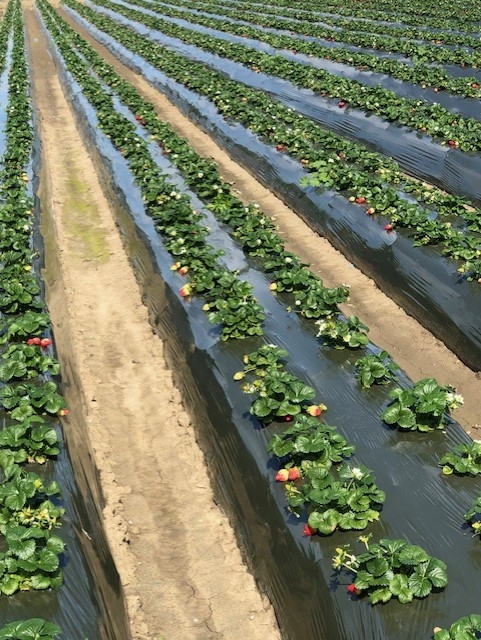
Things looking up in Watsonville
Anthracnose is Around Right Now – Caution Advised
We had picture brought in by a grower on Friday of some fruit from his field showing clear signs of anthracnose. That is to say, dark, lens shaped lesions on the fruit. It's understood that these are very early fruit and they have been exposed to some pretty tough conditions but nevertheless knowing that this disease is around gives reason for concern for local PCA's and growers.
While temperatures in the upcoming week are leaning on the cool side of the 20-25o C (68-77o F) optimum for the disease, the abundance of precipitation predicted and the resulting splashing onto flowers, fruit and leaves is going to be good for disease growth and spread.
Briefly, anthracnose in strawberry is most often caused by the pathogen Colletotrichum acutatum, and can have a number of sources, including the soil, the surrounding environment or the plants themselves. What we saw are the lesions on the fruit, and these lesions start as small sunken oval to round brown to black spots (some people describe them as “cigarette burns”) that can expand to the entire fruit.
What to do about an anthracnose fruit infestation in strawberry is fairly straightforward. For conventional growers there are several fungicides (see the UC IPM link below for specifics) registered for topical application, and if one is unable or not willing to spray, physical removal of the infested fruit will help to reduce the disease load.
A lot has been written about anthracnose in strawberry already:
https://ipm.ucanr.edu/agriculture/strawberry/anthracnose/
And we at the UC have put out a wonderful grower guideline about it as well:
https://ucanr.edu/blogs/strawberries_caneberries/blogfiles/47929.pdf
And that same guide is also available in Spanish:
https://ucanr.edu/blogs/strawberries_caneberries/blogfiles/47930.pdf
Also, the grower who came spoke Spanish and was wondering if we don't have the UC IPM guidelines in Spanish? Why, of course we do, the link is posted here:
https://ipm.ucanr.edu/legacy_assets/pdf/pmg/pmgstrawberry_espanol.pdf
Even more, Gerald Holmes from the CalPoly Strawberry Center wrote in to remind us of the excellent efficacy and timing guide that can be referenced for anthracnose in strawberry:
https://ipm.ucanr.edu/legacy_assets/pdf/pmg/fungicideefficacytiming.pdf
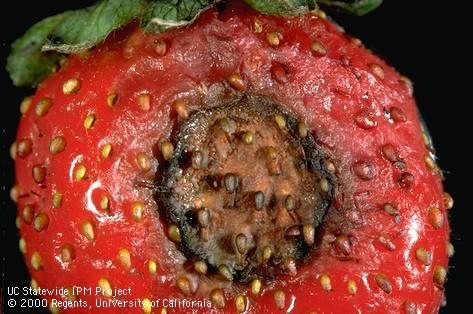
Classic symptom of anthracnose on strawberry fruit, brown to black sunken spot. Photo courtesy UC IPM.
Computer Coaching for Public Speaking?
2/22/2024
Just working this morning on a talk happening two weeks down the road and came across the option from the Powerpoint menu pictured below.
I'm curious, have any of you ever used this? While I think this would be useful in a way, I'd personally be concerned that this would take a lot of the fun and spontaneity out of a presentation. Too, looking at the wooden and stale speaking styles that are pretty standard of the "titans of tech" who were probably in charge of putting this coaching feature into Powerpoint, I'm not sure I should be taking tips from them. I'd rather look to politicians, the stage and stand up comedians for real tips on how to speak publicly.
Still, if any of you have used this feature with success, I'd sure like to hear about it.
2/23/2024
Thank you Chris Greer and Tunyalee Martin for the encouragement to check out myself the Computer Coach on Powerpoint.
So I had some time this afternoon + it's a beautiful day to be outside so I walked over to my office and gave the Computer Coach a whirl. It's a talk I've been preparing about how warming would affect strawberry fruit production on the Central Coast and transplant production in northern California.
The meeting is on March 6 at the UCCE office in Salinas, starts at 8 am, I'm on at noon and you have to register:
https://ucanr.edu/sites/uccemontereycounty/files/393932.pdf
Picture of the output is below. The Coaching is not too bad, sort of generic but could help a lot of people I think. A few observations:
You need to turn it on: I did one run through of the presentation, only to find I hadn't activated it. At least my audience will get a little bit more polished presentation out of the extra run.
I need to vary my voice volume: I'm pretty loud already, so maybe I drop it down a bit from time to time. I would counter this though to say when we academics, and quite frankly others charged with communicating information in a way that is supposed to inspire confidence, can't get too creative with the variation, because while granted you get people's attention it starts to tip into entertainment rather than information sharing. But, yes I'll concede to this point.
Some concern over bridge words: Words like "um", "you know" and "I mean" seemed to crop up more than I realize. It is hard to drop this though, I mean I am not leaning on the slide too much, it's mostly from memory so sometimes I need a sec, you know?
Some concern about reading off of the slide: This is interesting, you can see the three slides in question, which basically I followed verbatim but still while looking out at the audience. It's become popular to turn the captions on while watching TV to follow along better (I do it), so I see the writing on the slides as offering a similar benefit to the audience. Not conceding the point.
Good work on "inclusiveness": Curious as to what this was, it's about not using foul language, slurs or other verbal offense. Ok, thanks for the tip. I organize and chair meetings too, and always make sure to run a good clean show.
All in all, a helpful tool. Not something I am going to lean on too much, but something useful to deploy if not sure while pacing out out a talk during practice.
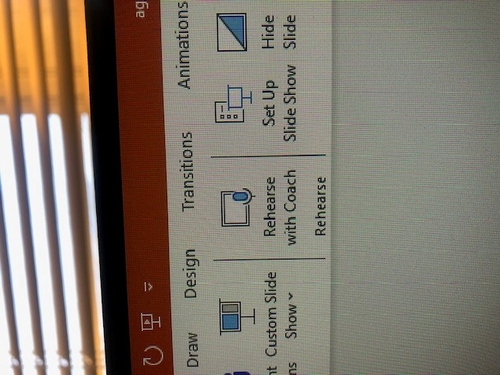
Interesting new feature on the Powerpoint
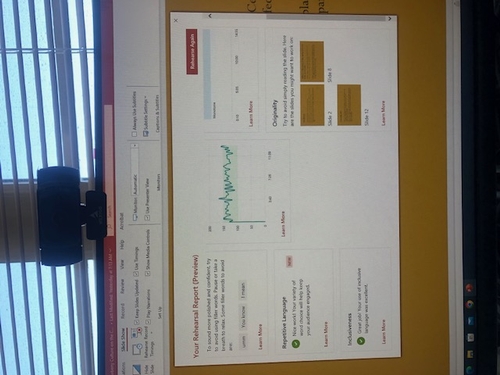
Output of my Computer Coaching session
Recording of February 14 UCCE Annual Strawberry Production Research Meeting
In case you missed it because of other obligations or you simply want to re-view favorite parts of our February 14 UCCE Annual Strawberry Production Research Meeting our Program Support Unit has provided me with a recording of the whole show.
It was a very good meeting, from start to finish interesting, well presented topics by leaders in the field. Thanks to all who worked hard to make this event such a success!
Here is the link.
Current Chill Calculations for the Central Coast - CIMIS Station #129
I had a local grower in our area call me last week about comparing the amount of chill accumulated so far this growing year, so I directed him to the UC Davis Fruits and Nuts site, which has a great chill calculator and also affords the opportunity to compare to the past years. There are two stations in the Watsonville area, #129 is behind the old Driscoll's research office off of San Juan Road in Pajaro, # 209 is closer to the shore and would be more moderated by the sea.
https://fruitsandnuts.ucdavis.edu/chill-calculator
I use the Utah model, which subtracts chill accumulation when temperatures go over 65 degrees Fahrenheit. I believe this is a good model since it reflects a lot going on with the plant's physiology.
Summary to Monday February 19 looks like chill this year is pretty well in line with years past. I did in fact pull some strawberry plants out at the end of January for a root starch, total non-soluble carbohydrate and sugar analysis to see how additive the effects of this chill are to critical components of the plant's physiology once it is in the ground. Stay tuned.
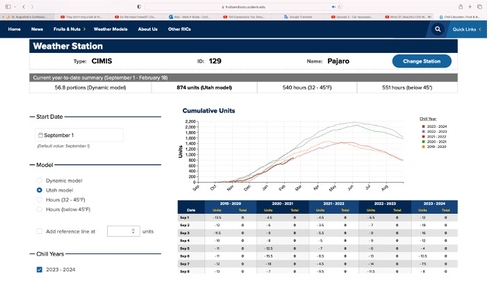
Slide1

